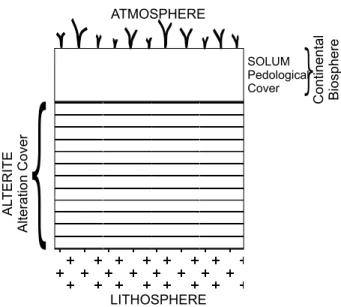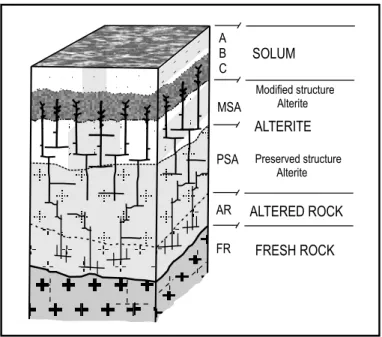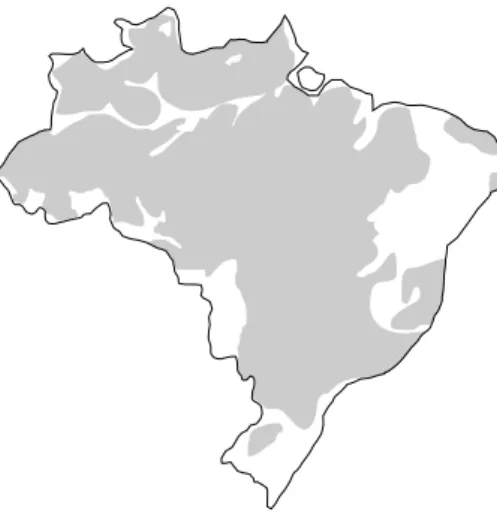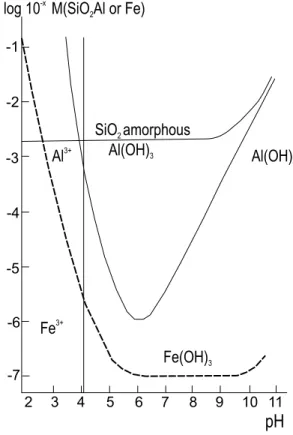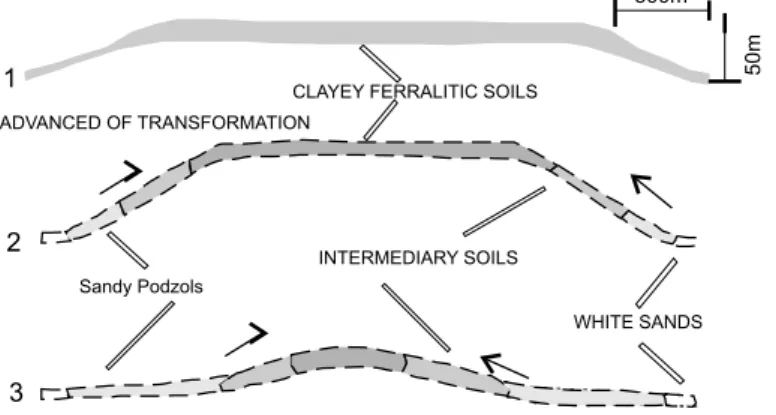www.scielo.br/aabc
Some topics on geochemistry of weathering: a review
MILTON L.L. FORMOSO
Instituto de Geociências – IG, Centro de Estudos em Petrologia e Geoquímica – CPGq Universidade Federal do Rio Grande do Sul – UFRGS, Av. Bento Gonçalves 9500, Bairro Agronomia
Caixa Postal 15001, 91509-900 Porto Alegre, RS, Brasil
Manuscript received on September 29, 2005; accepted for publication on March 13, 2006; contributed byMILTONL.L. FORMOSO*
ABSTRACT
Weathering is a complex process comprising physical disaggregation, chemical and biological decomposition of rocks and minerals transforming complex structure minerals in simpler ones. Hydrolysis of silicates is perhaps the most important process but associated certainly to biological weathering. It is discussed the role of waters: activities/concentrations of chemical species, pH, Eh, importance of complexes. Weathering is not only a destructive process. It can concentrate chemical species and form mineral deposits (kaolin, bauxite, Fe, Mn, P, Nb, Au). Weathering studies are important in pedology, engineering geology, hydrogeology, paleoclimatology and ecology. The use of stonemeal is based upon the study of rock weathering.
Key words:chemical weathering, hydrolysis of silicates, biological weathering, physicochemical parameters of weathering.
INTRODUCTION
Weathering is a process characterized mainly by physical disaggregation and chemical decompo-sition of rocks transforming structures of more complex minerals in others with simpler structures. The transformation of tectosilicates (feldspars) in 1:1 phylosilicates represents well this process. At the same time the neoformation of minerals such as kaolinites, iron oxides (goethite, hematite), aluminum oxides-hydroxides (gibbsite, boehmite) which are stable at low temperature and pres-sure (25◦C, 1 atm) replacing higher temperature and pressure minerals is also representative of supergene alteration.
The supergene alteration is dependent upon climate (rainfall and temperature), topography, nature of rock (fissural system, texture and composition), influence of biosphere and controlled by drainage conditions of the profile.
The hydrolysis of silicates is the most important process during the weathering. For example:
2KAISi3O8s,c,K-feldspar+11H2Ol =4H4SiO4aq+Al2Si2O5(OH)4s,c,kaolinite +2K +
aq+2OH−aq
s = solid; c = crystalline; aq = aqueous; l = liquid
Hydrolysis of silicates is characterized by increasing of pH (OH−), leaching of alkaline and earth alkaline cations and the partial or total leaching of H4SiO4. The formation of kaolinite means
a partial leaching of H4SiO4.
The supergene alteration of rocks produces “alterites” (Figs. 1 and 2). Alterites are constituted by neoformed supergenic minerals plus some primary minerals from preexisting rocks. (Fig. 1 – (Pedro 1985 in Melfi et al. 1999)).
Fig. 1 – Alteration cover (alterite + soil) in relation to atmosphere and continental biosphere (Pedro 1985).
CHEMICAL WEATHERING OF MINERALS
In principle, all minerals can undergo destruction by weathering but normally the primary minerals are less resistant than the secondary ones. Minerals can be listed according to their degree of resistance to weathering. Fig. 3 displays a list of minerals in order of increasing resistance to weathering.
Note: The exact position of minerals depends upon grain size, environmental conditions.
Sec-ondary minerals are at the bottom of the list as it could be expected. (See also Loughnan 1969, Carrol 1970, Berner and Berner 1996).
Fig. 2 – Lateritic profile of a tropical soil (Melfi et al. 1999).
Fig. 3 – Mineral weatherability (decreasing from top to bottom) Pyrite
Calcite Dolomite Olivine
Ca – plagioclase Pyroxenes
Ca – Na plagioclase Amphiboles
Biotite K – feldspar Muscovite Smectite Quartz Kaolinite
Gibbsite, hematite
(dislocations) on the mineral surface. (Nahon 1991). In general different chemical compositions and the formation of etch pits (feldspars, pyroxenes and amphiboles) control the dissolution of minerals.
Holdsen and Berner (1979) and Meunier (2003) present a discussion on the dissolution of pri-mary phases during the supergene alteration. Meunier (2003) emphasizes that the dissolution starts by the more energetic sites: surface, edges and vertices. The supergene alteration advances under corrosion zones formed by the coalescence of dissolution of materials at the sites of dissolution.
BIOLOGICAL WEATHERING
Although the weathering of rocks is both a mechanical and mainly a chemical process the biological influence is very important in the changes suffered by the rocks close to the surface. Acids produced around the roots of living plants and by the bacterial decomposition of plants interact with rock minerals increasing the chemical alteration of those minerals.
The upper part of the soil is a zone of intense biochemical activity. The bacterial population near the surface is large but decreases downward with a steep gradient. The organic acids mainly those with low molecular weight attack silicate minerals which commonly dissolve incongruently. For instance, an organic acid, as oxalic acid, dissociates to form H+ions:
H2C2O4aq =2H +
aq+C2O24−aq
The H+ions attack the silicate liberating its constituent chemical species:
H+
aq+4H2Ol+silicate=Alaq3++Mnaq++mH4SiO4aq
The C2O24−reacts with Al3+to form a chelate:
Al3+
aq +C2O42aq−=Al(C2O4) +
aq
This latter reaction is a dissolution reaction very common at the uppermost acid portion of most temperate soils.
Bacterial activity is responsible by the decomposition of the Al(C2O4)+ and H2C2O4. The
oxalic acid and the oxalate are oxidized to CO2and HCO−3 and the Al3+is liberated and precipitates
as Al(OH)3or clay minerals. Thus the organic acids are responsible mainly by the low pH and
formation of organic complexes. The process does not preserve the organic acid.
WEATHERING AND SOIL FORMATION
soil classification with ten types of soils according to climate and evolution. For example, oxysol is considered a deeply weathered, reddish, kaolinite, clay-rich and iron-rich soil of tropical hu-mid climates with almost no remaining primary minerals (formerly called laterites, lateritic soils, latosols). In tropical soils there is little burial of organic matter and there is still intense leaching of cations and silica due to heavier rainfall (>2000 mm per year). According to Melfi and Pedro
1977, the laterite and oxysols (latosols) cover about 65% of Brazil´s total surface, prevailing in all of Amazon, Central and Southeastern regions of this country (Fig. 4).
Fig. 4 – Area of lateritic cover (laterite and latosols) in Brazil (Melfi and Pedro 1977).
WATERS
Rain waters coming into contact with rocks (and derived soils) react with primary and secondary minerals or amorphous phases modifying the compositions of those waters. Rain waters increase their content of ions released from the rocks and organic matter from the biosphere constituting the soil waters. The composition of surface waters (in tropical and temperate areas) is represented by common cations Ca2+, Na+, Mg2+, K+ and normally the principal anion is HCO−
3. Activity
of ions, pH, Eh, complex ions can control the composition of soil, surface and ground waters. In dilute solutions activities and concentrations are almost equal because the activity coefficients are close to one (a =γm; a = activity; m = concentration andγ = activity coefficient).
a – pH
pH (= −log aH+) is controlled by the activity of various anions and cations. The
CO2=aH2CO3+aHCO−3 +aCO23−
material. The rain water is a dilute solution of carbonic acid and its pH is around 5.65 (without pollution). Rain water and surface waters coming into contact with rocks react with them which release cations, H4SiO4and OH−from the hydrolysis of silicates. Normally without the presence
of organic matter and vegetation, the hydrolysis of silicates predominates and the pH is higher than 7. The OH− predominates in comparison with organic acids and the pH is basic as happens in semiarid climates. In ground waters, the confined interaction between meteoric waters and rocks is still the most important factor and the influence of organic matter and products of its decomposition is much less important. The pH of ground waters is generally higher than 7. In surface waters (and in soil waters), the hydrolysis of silicates and the OH−produced are neutralized by the CO
2aq and by the organic acids formed in soils from the decomposition of organic debris. The resultant pH is lower than 7, in general, between 5.5 and 7 without anthropic pollution. In organic layers of the podsols, the pH may reach 3.5. The industrial contamination increases the content of sulfuric and nitric acids of the rain water constituting the acid rain. Normally the acid rain waters destroy the buffering ability of HCO−
3 leading to the decrease of pH of waters.
In sea water, there is also a competition between the acid volcanic gases and the hydrolysis of silicates (Sillén 1961); the acid volcanic gases are CO2, HCl, HF, SO2, H2S and the hydrolysis
of silicates is from sea floor and from erosion products of continents. The resultant pH is around 8.2–8.4. The sea water is buffered by the systemCO2especially the HCO−3 ion.
The HCO−
3 presents buffering ability in sea water and also in lakes and even in some rivers. The
equation HCO−
3aq+H+aq=H2CO3aqshows that the H+reacts with HCO−3 forming H2CO3which
ionizes very little. The concentration of HCO−
3 is almost equal at pH= 6.4 and 10.3 explaining
the buffering behavior of HCO−
3 at aCO2 =10−3(Fig. 5). In the presence of carbonate rocks
the buffering ability of HCO−
3 increases because of higher HCO
−
3 concentration:
H+
aq+CaCO3s =Ca
2+
aq +HCO−3aq.
b – Eh
The oxidation potential is another important parameter for the definition of geochemical charac-teristics of water. Chemical species of Fe, S, Mn, C present several oxidation numbers and have their behaviors dependent of Eh. The ratio Fe3+/Fe2+ is very important and the tendency is the oxidation of Fe2+
aq and the precipitation of Fe(OH)3 (or goethite and hematite). In latosols, the
oxidation-reduction of the Fe species is responsible (Fe2+
aq =Fe3
+
+e−) by the dissolution –
pre-cipitation of the Fe in this type of soil associated certainly to the oscillation of water table in wet and dry seasons.
Sulfur species especially S2− and SO2−
4 are important in terms of Eh/pH and the occurrence
of sulfides (FeS2) and SO24−are quite characteristic. In acid mine drainage (Kim and Chon 2001,
Roisenberg et al. 2004), the oxidation of pyrite forms Fe2+
aq, SO
2−
4aq+2H
+
aq and the later oxidation
of Fe2+ to Fe3+(or Fe(OH)
3). The pH reaches values close 2 and Fe3aq+ is in solution. When the
Fig. 5 –CO2(carbonate species) versus pH−CO2=10−3mol/l.
4+, 6+ and 7+). The Mn2+, Mn3+and Mn4+are very common and Mn6+and Mn7+are normally present in laboratory conditions (MnO2−
4 and MnO
−
4). The most common oxidation reaction in
terms of manganese is Mn2+
aq+2H2Ol =MnO2s,c+4H +
aq+2e
−.
Mn2+is more stable than Fe2+; in other words, the oxidation of Fe2
+is faster than Mn2+.
The oxidation of carbon compounds to CO2is one of the most common oxidation processes
in nature. The oxidation of carbon chemical species to CO2, H2CO3or HCO−3 is very common in
soils, sediments and waters. Other oxidation of ions as
U4+
aq =U
6+
aq +2e
−
; Ce3aq+=Ce4aq++e− and Eu2aq+=Eu3++e−
are also important but not so common as those described above (Fe, S, Mn, C). The use of Eh-pH diagrams became very frequent in geochemical literature in the last fifty years. (Garrels and Christ 1965).
c – Complex ions
Complex ions (inorganic or organic), ionic pairs (sea water) are association between ions or with other chemical species which are responsible by the transport of chemical species in solution. The stability of complex ions depends on their constants of stability. Carbonates form more stable complexes with HREE than LREE (it depends on ionic radius).
APPLICATION OF WEATHERING STUDIES
kaolin and bauxites may be formed in lateritic environment. (Fig. 6). For example, the genesis of kaolin of Rio Jarí (Montes et al. 2002) is related to the weathering of Cretaceous Alter do Chão Formation (Amazon) with the neoformation of a new generation of kaolinite and leaching of iron resulting in an enrichment of kaolinite forming the important deposits of Rio Jarí kaolin. Similarly, at the high places the more advanced leaching of H4SiO4led to the formation of bauxites.
Fig. 6 – The solubility of aluminum hydroxide, amorphous silica and ferric oxide in terms of ph in superficial conditions. In deposits of Fe and Mn is very common the oxidation and dissolution – precipitation of Fe and Mn, respectively.
b – In many cases, a thick lateritic cover might hide deeper important mineral deposits and we may use geochemical prospection of soils, sediments and waters for making the prospection of the elements we look for.
c – Other important application of weathering studies is the transformation of lateritic soils (or latosols) in podzols – (Pedro 1985, Lucas et al. 1989, Melfi et al. 1999).
will become more acid until the forests start degrading being replaced by “campinarana”, a new type of vegetation. The podzolization is characterized by the whitening of upper horizons with the individualization of a humic B horizon. The podzolided soils are formed from latosols in a transformation system (latosol – podzol).
Two types of water streams draining the system can be found. One type drains the lateritic basin; it displays clear water and is poor in dissolved organic material, high dissolved Si species and very low concentration of Al and Fe species. The second type, which drains podzolic regions, has brownish waters due to dissolved organic material and also has high concentration of iron and aluminum chemical species and low content of silicon dissolved species. The particulate fraction is important being made up of quartz, kaolinite and gibbsite. Organic-metalic complexes are responsible by the transport of Al and Fe species in solution (Melfi et al. 1999).
Fig. 7 – Stages of evolution of the lateritic – podzol soil systems in the Amazon Basin (Melfi et al. 1999).
d – Studies of weathering are fundamental in Engineering Geology, Hydrogeology and practical applications of Geology. In Engineering Geology, the search of materials used in the construction of roads, dams and houses include certainly studies of supergene alteration of those materials.
In Hydrogeology, the studies of ground and surface waters obviously involve the interaction water-rock (also supergene alterations).
e – Paleoclimatology and Ecology are very dependent on research in weathering. For example, the study of alterites and soils is important because they may be associated to the development of vegetation (including forests), playing an important role in the bioclimatic balance of the planet (Melfi et al. 1999).
Alterites (especially laterites) are important marks in Paleoclimatology mainly in regions tectonically stable.
STONEMEAL
According to Leonardos and Theodoro 1999, “Under our conditions of lateritic soils we must, as an important step towards sustainable development, restore to the leached soils, the balanced inorganic meal on which crops and biodiversity can be properly fed. Stonemeal is Nature’s approach to achieve overall soil fertility. The use of soluble fertilizers like NPK is only supported in limited amounts and only if coupled or preceded by stonemeal soil reminalization.”
The use of stonemeal has as principle the weathering of rocks with release of major species as (H4SiO4, Ca2+, Na+, Mg2+, K+) or minor species (Ni2+, CO2+, Cr3+and others), correction of
pH (OH−from hydrolysis of silicates).
The choice of the rock and conditions for stonemeal depends on various factors:
a – Chemical composition – for example, basic and alkaline rocks are ideal; rocks rich in SiO2,
especially quartz, are not adequate. Volcanic rocks are very good because the supergene alteration is not slow (fine grain, sometimes glass);
b – The transport of the rocks may not be long (increase cost);
c – The addition of organic material together is certainly very important because it would bring about a faster alteration of the stonemeal;
d – Normally the stonemeal must precede (or be simultaneous with) the addition of other fertilizers.
RESUMO
químicas e formar depósitos minerais (caolim, bauxita, Fe, Mn, P, Nb, Au). Estudos de intemperismo são importantes em pedologia, geologia de engenharia, hidrogeologia, paleoclimatologia e ecologia. O uso de rochagem é baseado em estudo de intemperismo de rocha.
Palavras-chave: intemperismo químico, hidrólise dos silicates, intemperismo biológico, fatores físico-químicos do intemperismo.
REFERENCES
BERNERKB AND BERNERRA. 1996. Global Enviromental: water, air and geochemical cycles. New Jersey, USA, Practice Hall, 376 p.
CARROLD. 1970. Rock weathering. New York, USA, Plenum Press.
FORMOSOMLLANDCERRICC. 1999. Workshop on Tropical Soils, Academia Brasileira de Ciências, Rio de Janeiro, RJ, Brasil, 192 p.
GARRELSRMANDCHRISTC. 1965. Solutions, minerals and equilibria. San Francisco, Freeman-Cooper, 450 p.
HOLDSENGRANDBERNERRA. 1979. Mechanism of feldspar weathering. In: EXPERIMENTALSTUD -IES. Geochim Cosmochim Acta 43: 1161–1171.
KIMJYANDCHONHT. 2001. Pollution of a water course impacted by acid mine drainage in the Imgok creek of the Gangreung coal field, Korea. Appl Geochem 16: 1387–1396.
LEONARDOSOHANDTHEODORO SH. 1999. Fertilizing tropical soils for sustainable development. In: FORMOSO MLL AND CERRI CC (Workshop on Tropical Soils), Academia Brasileira de Ciências, p. 143–153.
LOUGHNANF. 1969. Chemical weathering of the Silicate Minerals, New York, USA.
LUCASY. 1989. Systémes pédologiques en Amazonie brésilienne. Equilibres, déséquilibres et transfor-mations. Thèse Doc, Univ Poitiers, 157 p.
MELFIAJANDPEDROG. 1977. Estudo Geoquímico dos Solos e Formações Superficiais do Brasil. Parte I – Caracterização e repartição dos principais tipos de evolução pedogeoquímica. Rev Bras Geocienc 7(4): 11–22.
MELFIAJ, CERRI CC, FRITSCHE AND FORMOSOMLL. 1999. Tropical Soils: Genesis, distribution and degradation of lateritic pedological systems. In: FORMOSOMLLANDCERRICC (Workshop on Tropical Soils), Academia Brasileira de Ciências, p. 7–30.
MEUNIERA. 2003. Argiles. Paris, Contemporary Publishing International – GB Science Publisher, 433 p. MONTESCR, MELFIAJ, CARVALHOA, VIEIRA-COELHOACAND FORMOSOMLL. 2002. Genesis, mineralogy and geochemistry of kaolin deposits of the Jari River, Amapá State, Brazil. Clays Clay Miner 50: 494–503.
NAHONDD. 1991. Introduction to the Petrology of Soils and Chemical Weathering. New York, USA, J Wiley & Sons.
PEDROG. 1985. Le sol, composante majeure de la biosphere. Revue du Palais de la Découverte 15(4): 20–50.
RETALLACKGJ. 1990. Soils of the Past. London, Harper-Collins.
ROISENBERG C, FORMOSO MLL AND DANI N. 2004. Ground water contamination caused by coal processing activities in the Candiota Region, State of Rio Grande do Sul, Brazil. In: ENVIROMEN -TALGEOCHEMISTRY INTROPICAL COUNTRIES, 4th International Symposium, Búzios, RJ, Brazil, p. 237–241 (CD-ROM).
